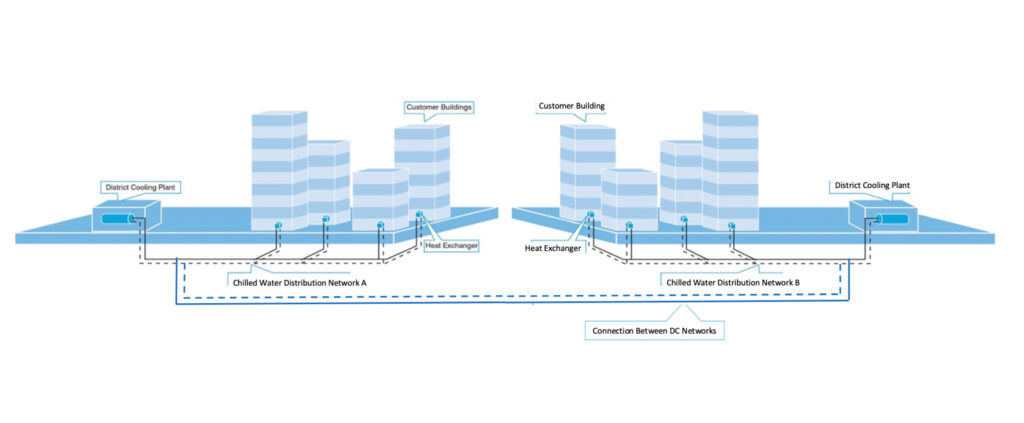The amalgamation of DCPs is perhaps the answer to greater penetration of district cooling in Dubai, says Nimal Amukotuwa
 The amalgamation of various district cooling plants in Dubai came up for substantial discussion during the DC Dialogue conference in September 2019 in Dubai and, more recently, during the DC Dialogue webinar, in June 2020. The main driver of the discussions was Dominic Mc Polin, Chief, Central Planning – Central Planning Office, Ministry of Works, Municipalities Affairs and Urban Planning, Bahrain. Indeed, he has been an ardent advocate of the proposed interconnection of district cooling plants in Bahrain. He has also spoken with passion on the subject, in the context of the sentiment in Bahrain.
The amalgamation of various district cooling plants in Dubai came up for substantial discussion during the DC Dialogue conference in September 2019 in Dubai and, more recently, during the DC Dialogue webinar, in June 2020. The main driver of the discussions was Dominic Mc Polin, Chief, Central Planning – Central Planning Office, Ministry of Works, Municipalities Affairs and Urban Planning, Bahrain. Indeed, he has been an ardent advocate of the proposed interconnection of district cooling plants in Bahrain. He has also spoken with passion on the subject, in the context of the sentiment in Bahrain.
Such a move would have its challenges, constraints and benefits. This article airs these.
As the topic is at its infancy, discussion of any specific district cooling plant or district cooling provider is not considered in this article; instead, the discussion is limited to the aspects indicated in the former paragraph, as possibly providing a stepping stone for further study of amalgamation.
Challenges and constraints of an amalgamation
The challenges and constraints of amalgamation would be the ones that would first require consideration and discussion.
These could be listed as…
The requirements of the various district cooling providers in making these connections
The district cooling in Dubai is regulated by the Regulatory & Supervisory Bureau (RSB) for electricity and water. The Bureau is responsible for terms of licensing, district cooling providers and billing. The Bureau’s remit also includes arbitrating or mediating disputes.
The main district cooling providers in Dubai could be considered as:
The requirements of the above and other smaller providers need to be ascertained and then formulated, in order to have an agreement among all the providers. The authority of the RSB ought to include these and other requirements/aspects, needed to provide a smooth amalgamation of the systems.
The practical and physical task of connecting the various district cooling plants
The existing district cooling plants in Dubai are spread over many districts or areas, including Mirdif, Dubai Investment Park, Palm Jumeirah, Jumeirah Beach Residence, and central Dubai (Dubai Healthcare City, Dubai International Financial Centre, Downtown Dubai and Sheikh Zayed Road North). For it to be practical, the amalgamation of district cooling plants only in areas adjacent to one another should be considered; outlying areas, such as Mirdif and Dubai Investment Park, should remain as standalone district cooling plants within those areas.
A feasibility study is required to ascertain the connection arrangement between the different district cooling networks. The scope of study ought to include pipework, pumping requirements and the chilled water that could be provided from one network to the other.
Installation of energy transfer stations (ETSes) among the networks is not recommended due to the possible energy loss, related to a rise in temperature.
Having a similar or identical quality of water in all the plants being connected
An essential factor in the amalgamation is the quality of water among the various networks being connected. It needs to be similar in quality, if the networks are directly connected to one another without an ETS.
The quality of water, as a requirement, needs to be added to the responsibility of the RSB. In addition to providing a guideline, the RSB ought to have a team to monitor the maintenance of the quality of water.
Determining a rate each provider would receive per kWh.r (kilo Watt hour of refrigeration) supplied by the provider
Equally, the RSB ought to establish a tariff for district cooling chilled water usage. The tariff should be such that the benefits of district cooling providers as well as of end users are considered.
It also should be the responsibility of the RSB to ensure that only BTU meters approved by RSB are used to monitor and record the end user consumption.
Benefits of an amalgamation
Amalgamation could result in…
Lower energy consumption, achieved through having a more distributed or spread out district cooling connection to properties
With the amalgamation of the district cooling plants/networks, the demand on chilled water on each district cooling plant would be more stable; it would also be consistent with end user demand. As such, the district cooling plant would be able to operate at a better delta T than when loads fluctuate regularly, providing a more energy-efficient operation.
Also, with amalgamation, the properties between the connected areas could be connected, as well, increasing end user demand. Further, amalgamation would assist district cooling providers in operating their plants at a higher efficiency, as they would be operating a higher load.
The saving in energy is a benefit to the Dubai government, as electricity consumption would reduce, enabling DEWA to produce less electrical energy.
Benefits to the district cooling provider
As mentioned above, the district cooling provider is able to benefit from the plant operating in a more stable and consistent mode, paving the way for a better delta T and for increased demand from end users added to the network through the interconnection.
Benefit to the end user
The considered benefit to the end user would be a lower tariff. This, in turn, would pave way for greater acceptance of district cooling.

Nimal Amukotuwa
The writer is an independent MEP consultant. He may be contacted at namukotuwa@gmail.com
#HVAC #HVACR #airconditioning #buildingperformance #airconditioningmiddleeast #airconditioningdubai #HVACDubai #HVACRDubai #HVACUAE #HVACRUAE #districtcooling #districtcoolingDubai #districtcoolingUAE #DeltaT #energyefficiency #interconnection #HVACBahrain #HVACRBahrain #districtcoolingBahrain #ETS #energytransferstations #DCPs #RSB #DubaiRSB
Copyright © 2006-2025 - CPI Industry. All rights reserved.